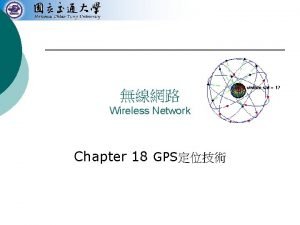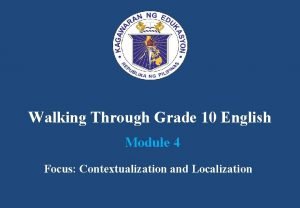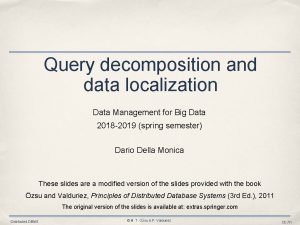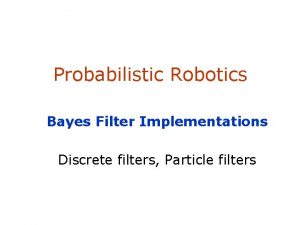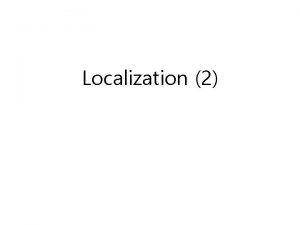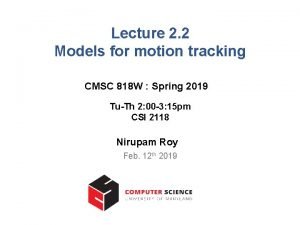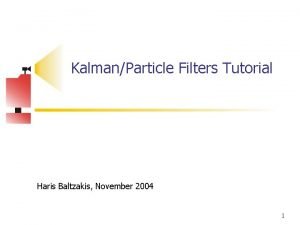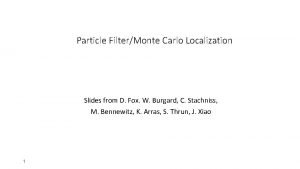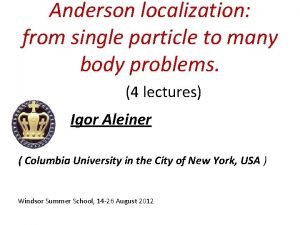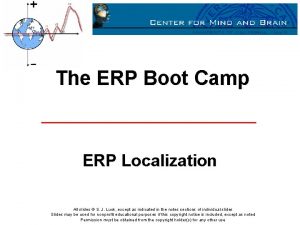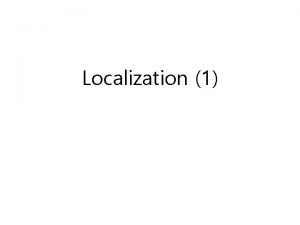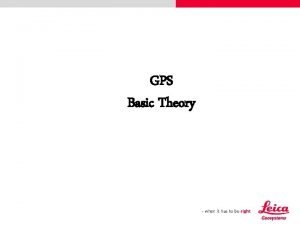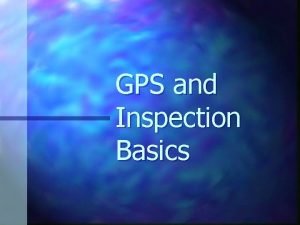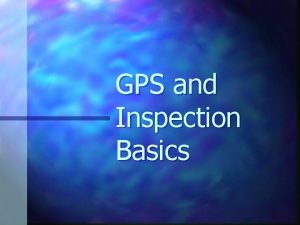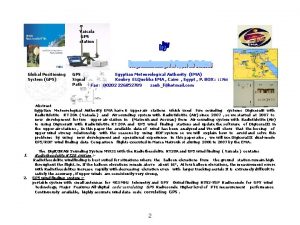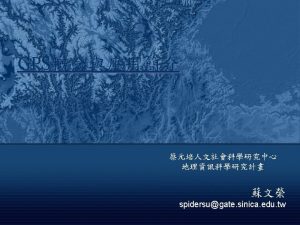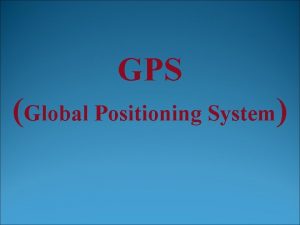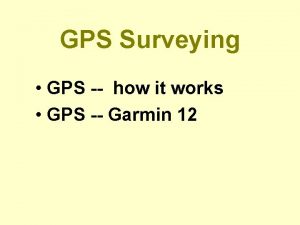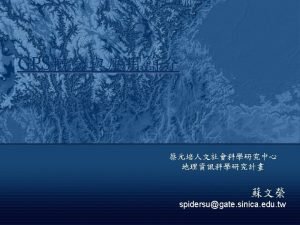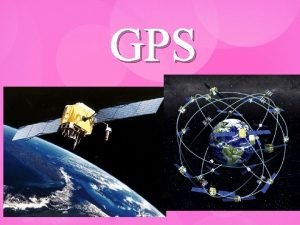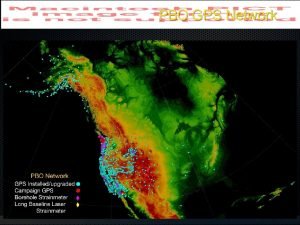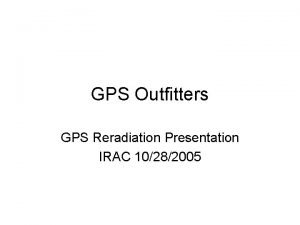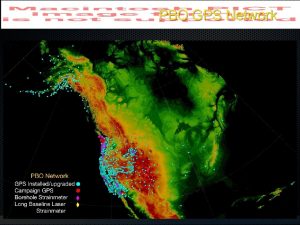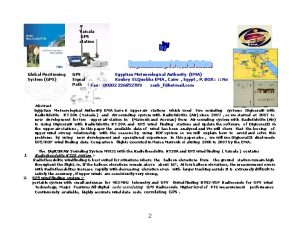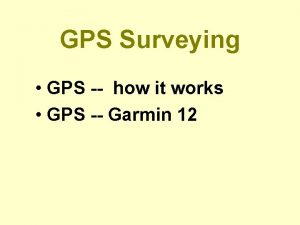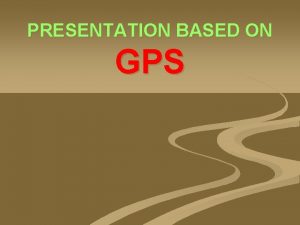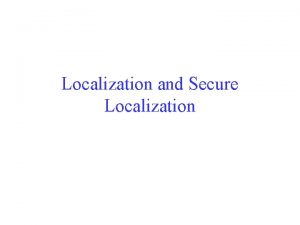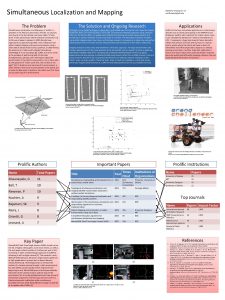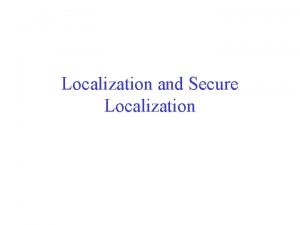Localization with GPS From GPS Theory and Practice






























- Slides: 30

Localization with GPS From GPS Theory and Practice Fifth Edition Presented by Martin Constantine

Introduction w GPS = Global Positioning System w Three segments: 1. Space (24 satellites) 2. Control (DOD) 3. User (civilian and military receivers)

GPS Overview w Satellites transmit L 1 and L 2 signals w L 1 --two pseudorandom noise signals – Protected (P-)code – Course acquisition (C/A) code (most civilian receivers) w L 2 --P-code only w Anti-spoofing adds noise to the P-code, resulting in Y-code

Observables w Code pseudoranges

Observables w Phase pseudoranges – N = number of cycles between satellite and receiver

Observables w Doppler Data – Dots indicate derivatives wrt time.

Observables w Biases and Noise

Combining Observables w Generally w Linear combinations with integers w Linear combinations with real numbers w Smoothing

Mathematical Models for Positioning w Point positioning w Differential positioning – With code ranges – With phase ranges w Relative positioning – Single differences – Double differences – Triple differences

Point Positioning With Code Ranges With Carrier Phases With Doppler Data

Differential Positioning Two receivers used: • Fixed, A: Determines PRC and RRC • Rover, B: Performs point pos’ning with PRC and RRC from A With Code Ranges

Differential Positioning With Phase Ranges

Relative Positioning Aim is to determine the baseline vector A->B. A is known, B is the reference point Assumptions: A, B are simultaneously observed Single Differences: • two points and one satellite • Phase equation of each point is differenced to yield

Relative Positioning w Double differences – Two points and two satellites – Difference of two single-differences gives

Relative Positioning w Triple-Differences – Difference of double-differences across two epochs

Adjustment of Mathematical Models w Models above need adjusting so that they are in a linear form. w Idea is to linearize the distance metrics which carry the form:

Adjustment of Mathematical Models w Each coordinate is decomposed as follows: Allowing the Taylor series expansion of f

Adjustment of Mathematical Models w Computing the partial derivatives and substituting preliminary equations yields the linear equation:

Linear Models w Point Positioning with Code Ranges – Recall: – Substitution of the linearized term (prev. slide) and rearranging all unknowns to the left, gives:

Linear Models w Point Positioning with Code Ranges w Four unknowns implies the need for four satellites. Let:

Linear Models w Point Positioning with Code Ranges w Assuming satellites numbered from 1 to 4 Superscripts denote satellite numbers, not indices.

Linear Models Point Positioning with Code Ranges • We can now express the model in matrix form as l = Ax where

Linear Models Point Positioning with Carrier Phases • Similarly computed. • Ambiguities in the model raise the number of unknowns from 4 to 8 • Need three epochs to solve the system. It produces 12 equations with 10 unknowns.

Linear Models Point Positioning with Carrier Phases Linear Model

Linear Models Point Positioning with Carrier Phases l = Ax

Linear Models Relative Positioning • Carrier phases considered • Double-differences treated • Recall: DD equation * γ • The second term on the lhs is expanded and linearized as in previous models to yield:

Linear Models Relative Positioning • The second term on the lhs is expanded and linearized as in previous models to yield ( [9. 133]…see paper pg 262) • l’s:

Linear Models Relative Positioning • The right hand side is abbreviated as follows (a’s):

Linear Models Relative Positioning • Since the coordinates of A must be known, the number of unknowns is reduced by three. Now, 4 satellites (j, k, l, m) and two epochs are needed to solve the system.

Extra References w Introduction and overview: http: //www. gpsy. org/gpsinfo/gps-faq. txt
 Gps gps gps
Gps gps gps Gps gps gps
Gps gps gps English module grade 10
English module grade 10 Query decomposition in dbms
Query decomposition in dbms Legal basis of contextualization and localization
Legal basis of contextualization and localization Contextualization and localization
Contextualization and localization Voice localization using nearby wall reflections
Voice localization using nearby wall reflections Neural network ib psychology
Neural network ib psychology Localisation of distributed data
Localisation of distributed data Bayes filter
Bayes filter Localization of behavior
Localization of behavior Buccal object rule
Buccal object rule Monte carlo localization for mobile robots
Monte carlo localization for mobile robots Icu localization
Icu localization Markov localization
Markov localization Markov localization
Markov localization Markov localization
Markov localization Localization in mobile computing
Localization in mobile computing Inclusive localization
Inclusive localization Markov localization
Markov localization Monte carlo localization python
Monte carlo localization python Localization in html5
Localization in html5 Localization industry standards association
Localization industry standards association Anderson localization lecture notes
Anderson localization lecture notes Dnn localization
Dnn localization Dynamics nav localization
Dynamics nav localization Mobile robot localization
Mobile robot localization Cump erp
Cump erp Labelling of radiopharmaceuticals
Labelling of radiopharmaceuticals Merkel disc receptor
Merkel disc receptor Www.youtube.com
Www.youtube.com
